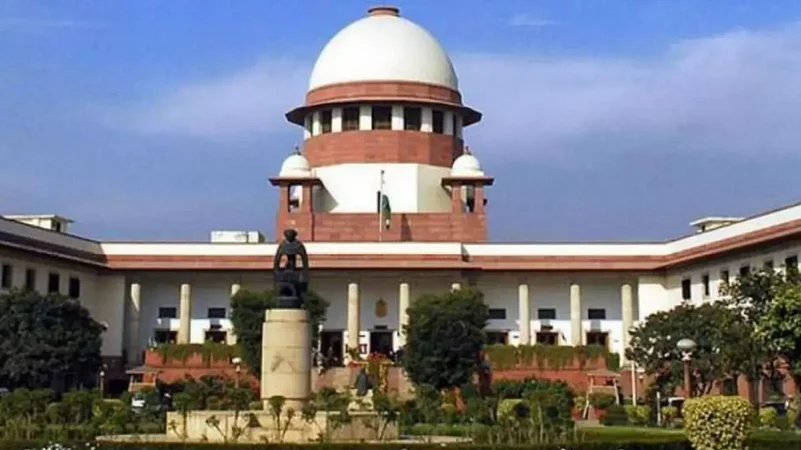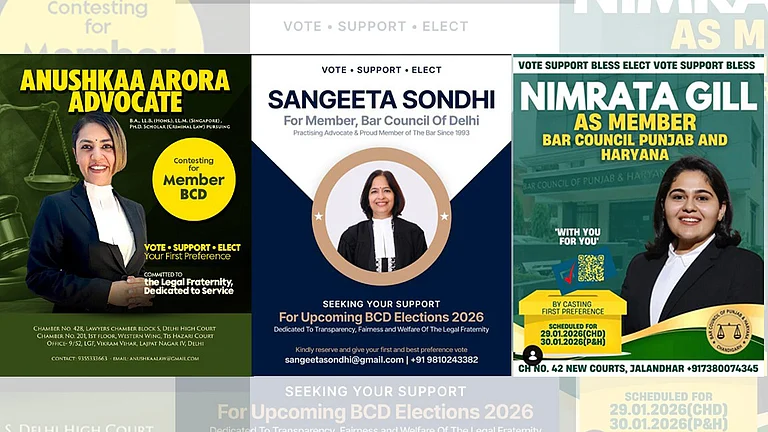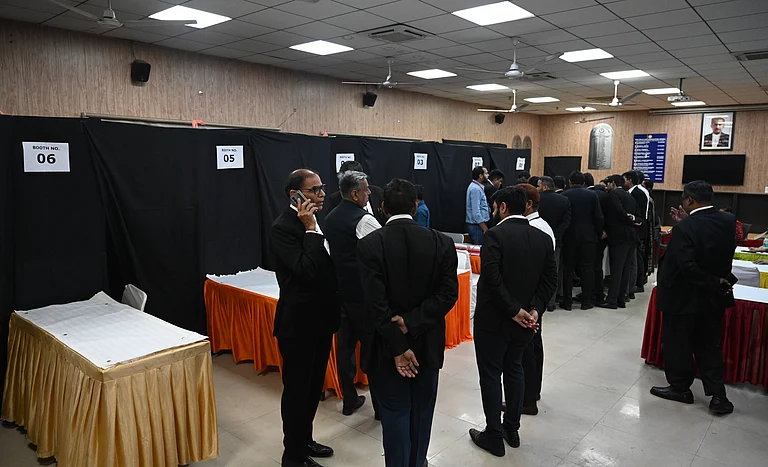The Narendra Modi-led Union government in 2019 brought in the 103rd Amendment to the Constitution of India, which paved the way for 10 per cent reservation to economically weaker sections (EWS) of the Indian society.
Reservation is the most visible form of affirmative action in India, so when it was extended to economically disadvantaged groups, it was hailed by supporters as a way to uplift the poorer sections. However, the critics said the EWS reservation goes against the very idea of reservation, which was meant for groups that were marginalised socially throughout history, such as scheduled castes (SCs) and scheduled tribes (STs).
The constitutionality of the amendment was challenged in the Supreme Court. On November 7, a five-judge bench of the Supreme Court ruled in a 3:2 judgement that the 103rd amendment and the resultant EWS reservation were constitutional and did not violate the basic structure of the Constitution.
However, two Supreme Court judges, including the then-Chief Justice of India (CJI) UU Lalit, dissented. Though they found EWS reservations permissible, they found the amendment in its entirety unconstitutional.
The history of reservation in India
The idea of reservation in India is not a post-Independence concept. It dates to the late 19th century. The British set up the Education Commission in 1880, commonly called Hunter Commission as it was headed by Sir Willian Wilson Hunter. Reformer Jyotirao Phule petitioned the Commission that the British should introduce reservation for the historically marginalised groups.
“In 1880, the colonial government set Hunter Commission to suggest measures to give reservation in the government positions to the socially backward classes. Jyotirao Phule made a plea before the Hunter Commission to grant reservation to these classes,” notes a publication of the Indira Gandhi National Open University (IGNOU).
In 1902, Kolhapur ruler Chhatrapati Shahu implemented 50 per cent reservation for the backward classes, which mostly meant non-Brahmins at the time. Other princely states too took the lead in affirmative action.
“Some of these princely states were progressive and eager to modernise through the promotion of education and industry; and by maintaining unity among their own people. Mysore in south India and Baroda and Kolhapur in western India took considerable interest in the awakening and advancement of the minorities and deprived sections of society,” notes Bhagwan Das in Economic and Political Weekly.
In 1921, Madras government reserved 44 per cent jobs for non-Brahmins and and16 per cent for Brahmins, Muslims, and Christians, and Anglo Indians each, according to the IGNOU publication cited above.
In 1932, seats were reserved in provincial assemblies under the Poona Pact, which was a compromise after consensus could not be built on the Communal Award —another method of reservation— proposed by the British.
Reservation in the Constitution of India
The reservation is mentioned in Article 46 of Part IV of the Constitution of India, which contains Directive Principles of State Policy (DPSPs). These provisions are non-enforceable but are meant to serve as guiding principles for lawmakers. Several of the provisions mentioned here, including reservations, have been made into laws over the years.
“Since 1950, the successive governments at the Centre and in the states have made several laws and formulated various programmes for implementing the Directive Principles of State Policies,” notes M Laxmikanth in his book Indian Polity, and lists some examples like the establishment of Planning Commission, laws for minimum wages and equal treatment of workers, maternity benefit laws, legal aid provisions, etc.
Article 46 states, “The state shall promote with special care the educational and economic interests of the weaker sections of the people, and, in particular, of the Scheduled Castes and the Scheduled Tribes, and shall protect them from social injustice and all forms of exploitation.”
The principle of Article 46 is reflected in Articles 15 and 16 of the Constitution which actually provide for the provisions of reservations in education and employment.
Moreover, Articles 330 and 332 of the Constitution reserve seats for SCs and STs in Lok Sabha and state assemblies.
However, the provisions in Article 15 were only added in 1951 through a constitutional amendment after the Supreme Court judgement nullified state reservations.
Court judgements on reservation
Reservation policies have seen multiple judicial interpretations over the years. The first in the series of rulings came soon after the Constitution came into being. The ruling led to the then-Prime Minister Pandit Jawaharlal Nehru to bring a constitutional amendment to overrule it.
Champakam Dorairaj vs State of Madras, 1951
The Supreme Court ruled that reservations for communities violated the equality provisions in the Constitution of India. The case concerned the reservation province in Madras (present-day Tamil Nadu).
“The classification in the Communal GO [government order, which gave the reservation under dispute in court] proceeds on the basis of religion, race and caste. In our view, the classification made in the Communal GO is opposed to the Constitution and constitutes a clear violation of the fundamental rights guaranteed to the citizen under article 29(2),” said the Supreme Court in its judgement.
To restore caste-based judgement, Nehru brought in the 1st Amendment to the Constitution which enabled reservations by adding Article 15 (4).
“It is laid down in article 46 as a directive principle of state policy that the state should promote with special care the educational and economic interests of the weaker sections of the people and protect them from social injustice. In order that any special provision that the state may make for the educational, economic or social advancement of any backward class of citizens may not be challenged on the ground of being discriminatory, it is proposed that Article 15(3) should be suitably amplified,” said Nehru while moving the amendment.
The amendment restored the reservation but had far-reaching consequences as it set precedent for the Executive nullifying court rulings through legislation.
MR Balaji vs State of Mysore, 1963
The Supreme Court judgement introduced the concept of “reasonable limits” on the reservation. It also held that while Article 15 (4) serves the historically disadvantaged, it cannot bypass the interests of the society.
The case was centred around the then-state of Mysore’s policy of providing 68 per cent reservation in educational institutions.
The SC said, “Reservation should and must be adopted to advance the prospects of weaker sections of society, but while doing so, care should be taken not to exclude admission to higher educational centres of deserving and qualified candidates of other communities. Reservations under Arts. 15 (4) and 16 (4) must be within reasonable limits.
“The interests of weaker sections of society, which are a first charge on the states and the Centre, have to be adjusted with the interests of the community as a whole. Speaking generally and in a broad way, a special provision should be less than 50 per cent. The actual percentage must depend upon the relevant prevailing circumstances in each case.”
This judgement is crucial as it served as the basis of the 50 per cent cap on reservation.
Indra Sawhney vs Union of India, 1992
This is the most well-known judgement on reservation that was pronounced by the Supreme Court. It was in response to a petition filed by Indra Sawhney against the Other Backward Classes (OBC) reservations provided by the government in response to Mandal Commission recommendations.
The Mandal Commission in 1980 recommended 27 per cent reservation to OBCs. The Vishwanath Pratap Singh-led Union government in 1990 accepted the recommendations. The government decision was challenged and it came up before the nine-judge-bench of the Supreme Court. In all its history, the Supreme Court has had a nine-judge-bench only in 17 cases.
The Supreme Court in a 6:3 judgement upheld the OBC reservation but imposed some conditions. Among other rulings in the case, the Supreme Court gave an important interpretation that reservation is meant to be adequate to disadvantaged communities, not proportional.
“The Apex Court has held that it is not possible to accept the theory of proportionate representation though the proportion of population of Backward Classes to the total population would certainly be relevant and held that the power conferred by clause (4) of article 16 should be exercised in a fair manner and within reasonable limits so that reservation does not exceed 50%,” notes a Union government circular as saying of the SC judgement.
The Supreme Court further introduced the concepts of “creamy layer” and reinstated the 50 per cent reservation ceiling. The creamy layer refers to the well-off sections within OBCs. The SC said that such people will be excluded from reservation.
“There are sections among the backward classes who are highly advanced, socially and educationally and they constitute the forward section of that community. These advanced sections do not belong to the true backward class. They are as forward as any other forward class member. If some of the members are far too advanced socially (which in the context necessarily means economically and may also mean educationally), the connecting thread between them and the remaining class snaps,” notes the SC in the judgement, as per the copy available on the website.
However, the SC also noted in the judgement that economic criteria cannot be the only basis for reservation. This part of the Indra Sawhney judgement is central to the criticism and questioning of EWS reservation.
The judgement also said reservations do not apply to promotions and only apply to initial appointments. The government in a subsequent constitutional amendment overturned this part of the judgement.
M Nagaraj & Others vs Union of India & Others, 2006
The judgement is important as it laid down conditions under which the 50 per cent ceiling can be crossed. It is further important as the Supreme Court also ruled that, for reservation-related provisions, the government has to show it has objective and quantifiable data to substantiate it.
The judgement also overruled the earlier ruling on bar on reservation in promotion. However, though the reservation in promotion was enabled, there was a condition — the state had to show quantifiable data to prove backwardness of the community concerned.
“The state is not bound to make reservation for SC/ST in matter of promotions. However if they wish to exercise their discretion and make such provision, the State has to collect quantifiable data showing backwardness of the class and inadequacy of representation of that class in public employment in addition to compliance of Article 335,” ruled the Supreme Court.
The EWS reservation judgement, 2022
Following the Narendra Modi government’s introduction of EWS reservation in 2019, a number of petitions were filed. The Supreme Court decided on those petitions on November 7, ruling that the EWS reservation was constitutional.
There were three main questions in front of the Supreme Court in the EWS reservation case:
- Did the EWS reservation violate Indra Sawhney judgement as it crosses the 50 per cent cap?
- Can economic status be the sole criteria of reservation?
- Can SC/ST/OBCs be excluded from the EWS reservation?
The first two questions stem from the Indra Sawhney judgement.
The three judges in their majority judgement said yes to these questions whereas the two dissenting judges said no.
The majority judgement ruled that affirmative action is not just for socially and educationally backward but for all classes of backward people.
“It is an instrument not only for inclusion of socially and educationally backward classes to the mainstream of society but, also for inclusion of any class or section so disadvantaged as to be answering the description of a weaker section. In this background, reservation structured singularly on economic criteria does not violate any essential feature of the Constitution of India and does not cause any damage to the basic structure of the Constitution of India,” said Justice Dinesh Maheshwari in his majority judgement.
The majority judgement further said the 50 per cent ceiling is not inflexible and the 50 per cent ceiling applies only to reservation to socially and educationally backward classes, not to any other kind of reservation. Therefore, economically weaker sections —since they are a separate class— can have reservation outside of the 50 per cent ceiling, according to the Supreme Court.
The dissenting judgement, authored by Justice Ravindra Bhat, however, held the EWS reservation unconstitutional as it excludes SCs/STs/OBCs —with the reasoning that they enjoy another type of reservation— and that it breaches the 50 per cent reservation ceiling set in previous judgements. The dissenting judges were in principle okay with reservation on economic grounds.
Unaddressed questions and politics of reservation
The breach of the 50 per cent cap on reservations in the Supreme Court judgement on EWS reservations has paved way for several parties and states to propose their own reservation policies breaching 50 per cent cap,
In September, Hemant Soren-led government increased reservation in Jharkhand to 77 per cent. At the time, a Ranchi-based lawyer told Outlook that the provision would not stand judicial scrutiny as it crosses the 50 per cent ceiling set by the Supreme Court. But that’s not certain anymore.
“The judgement is not legally very sound. It opens a Pandora’s Box as many states and parties would now come with their populist policies,” says Vinod Shankar Mishra, Professor, Faculty of Law, Banaras Hindu University (BHU), adding that a five-judge-bench should not be overruling the nine-judge-bench of Indra Sawhney case.
Mishra further tells Outlook that the reservation has always been group-focussed and EWS makes it individual-focused.
“EWS rests on individual economic conditions whereas the reservation was meant for the benefit for the historically marginalised groups. This was the principle of reservation,” says Mishra, adding that the Rs 8 lakh criteria for EWS is also very wide and would include the vast majority of the population.
He further says, “Earlier judgements such as Nagaraj (2006) have held that you need to show data for such things. The data and the reasoning are not very sound. A nine-judge bench or an eleven-judge bench can clarify this judgement in the future as the judgement has far-reaching consequences but not sound reasoning.”


























